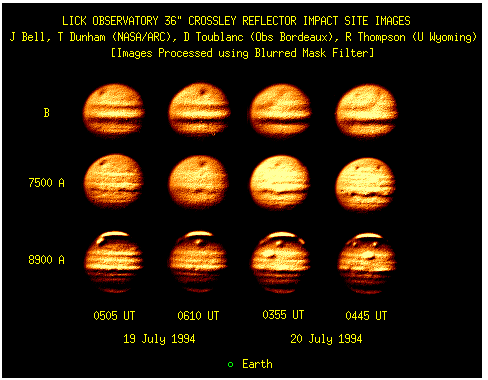Ted Dunham (NASA Ames)
Dominique Toublanc (Obs. Bordeaux)
Bob Thompson (Univ. Wyoming)


This is a mosaic of 12 images obtained on 19 and 20 July UT from the Lick Observatory Crossley 36" reflector using a high speed CCD camera system. Images are shown that were obtained through a Bessel B filter (top row), a 7500 +/- 100A narrowband filter (middle row), and an 8900 +/- 100A narrowband filter (bottom row). Each of the columns depicts images at these wavelengths obtained at roughly the same time.
South is up in these images. For scale, the apparent size of the Earth is indicated at the bottom of the image. The raw data have been processed using a blurred mask filter to enhance details. In this filtering scheme, the image is gaussian filtered and then the difference between the original image and the gaussian filtered version is amplified and added to the original image. The resulting images have been contrast stretched to bring out the most detail around latitudes centered on the impact sites.
The various impact spots observed are: [1] 19 July 0505 UT: G on dawn limb; [2] 19 July 0610 UT: G on central meridian; [3] 20 July 0355 UT: A (and E?) on dawn limb, H on central meridian, G on evening limb; [4] 20 July 0445 UT: A (and E?) to the left of the central meridian, H to the right of the central meridian.
Note that the spots are bright in our 8900A images but dark in all of our other filters. This is consistent with HST imaging results, but there is some confusion about whether the spots are bright or dark in 8900A groundbased images. Many groups have reported that the impact sites are NOT visible as bright spots using the Spencer et al. 8930 +/- 300A filter. However, we are using an 8900 +/- 100A filter and we see the impact sites as prominent features comparable in brightness to the GRS. We offer the following explanation for this discrepancy: the 8930 +/- 300 filters are centered on Jupiter's methane band but they also are measuring some of the continuum signature on either side of the band (see West, Icarus vol 38., p. 14, 1979). Our 8900 +/- 100 filter does not allow any of the surrounding continuum to "leak" in and thus allows a higher degree of contrast in the images. This may also explain why the spots are bright at 8900A for HST.
Also of note is the dark partial ring seen apparently surrounding the A site in the 20 July images. This dark arc-like structure extends from the south pole up to -20 degrees S latitude and is centered on the A impact site (which was also dark in our B images). The arc has a radius of roughly 10 arcsec. The structure is also visible in our U band images but is not visible in any of our narrowband filters. There are at least two immediately obvious possible explanations for this feature: (1) it may be the visible expression of an expanding shell (or wave) of material from the A impact site: the feature is large because the A site is oldest; (2) it may be an artifact introduced by a combination of 2-arcsec seeing and the fortuitous alignment of the GRS and H impact site along an annulus concentric to the A site. This structure was also reported to be seen in B images by E. Howell and co-workers at Mount Stromlo.
Lick Observatory Crossley 36" reflector observing team:
Jim Bell (NASA Ames)
Ted Dunham (NASA Ames)
Dominique Toublanc (Obs. Bordeaux)
Bob Thompson (Univ. Wyoming)
![]() Images, Images, Images
Images, Images, Images
